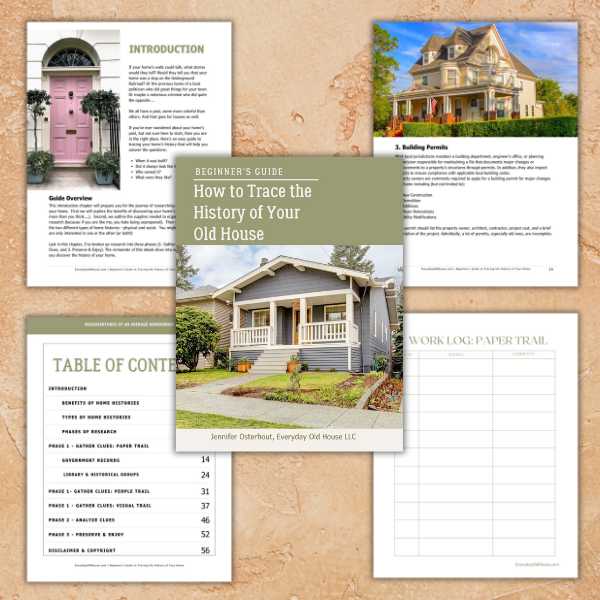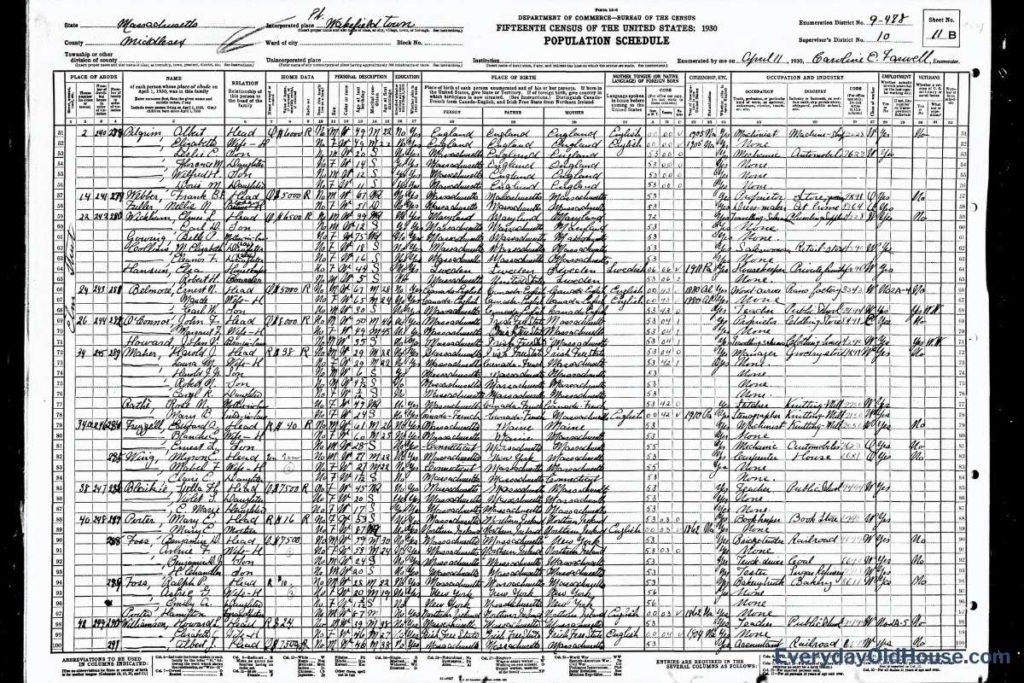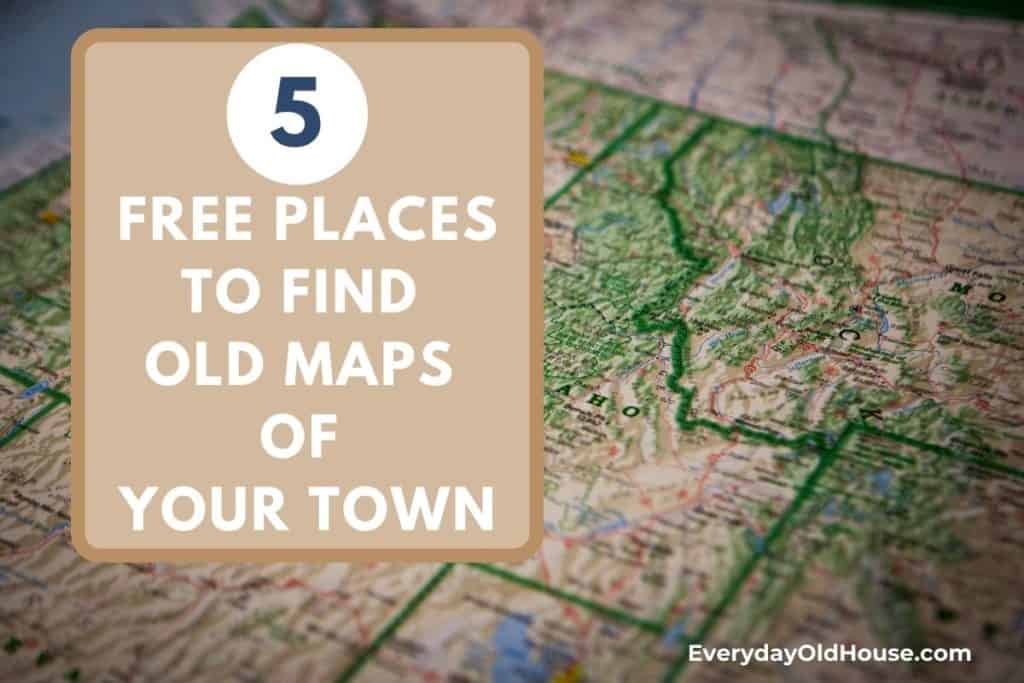If you’re curious about the history of your old house, you have probably wondered about the people who used to live there. Did they live there a long time? Was it a large family? Where did they work? If only your walls could talk, the stories they could tell. Unfortunately that’s not the case, so here’s 7 Easy Ways to research who lived in your house.

This post contains affiliate links, including but not limited to, Amazon Associates. As such, I earn from qualifying purchases. Full disclosure located here.
BEGINNER’S GUIDE TO HOME HISTORY RESEARCH
Interested in researching the history of your old house but unsure where to start? Grab my newly-release:
Beginner’s Guide: How to Trace the History of Your Old House
This 60-page guide takes you step-by-step through 25+ online and in-person resources to create a picture of your home’s history.

Who Lived in Your House?
Our homes often serve as the backdrop for so many family photographs marking milestones. Documenting momentous occasions such as graduations, holidays, and baby’s first steps. Wouldn’t it be wonderful to uncover these stories in your old house?
Here’s 7 easy ways to research who lived in your house. Luckily, many of these resources are available online, and either free or low cost to access.
Good luck in your search!
1. Deed Registrar
A deed is a legal written document that records the sale of a property. In other words, if you hold the deed, then you prove ownership to the property.
Commonly, a county’s Registry or Recorder of Deeds collects and records all deeds. Some recorders have on-line databases allowing you to research from the comfort of your own home, while others require you research in-person at their offices.
Or, some counties (like mine) provide only recent deeds online (e.g. the last 30 years). If you want to look at older deeds, a trip to the registry is required.
A deed is a complicated legal document, which consists of multiple pages and a lot of information. As the average homeowner, I found some of the deed difficult to interpret. And downright tedious. BUT not to worry.
If you are looking to figure out who lived in your house before you, you just need to identify the names of the sellers and buyers. A deed transfers title (aka “ownership”) from a seller (the “Grantor”) to the buyer (the “Grantee”).
If you find an older deed, you might even get bonus info on the Grantor and Grantee’s occupations.
Tip: If you are looking for deeds on-line, make sure that you are on the official Registry website and not a business website that will charge you for the information.
2. Assessor/Tax Records
Taxpayers in every state (and District of Columbia) pay property taxes, which is a tax levied on “real property” (i.e., land and buildings). Lucky us….
Responsibility for collecting these taxes falls at the local government level, usually through the Tax Assessor or Tax Appraiser. This department is responsible for assessing the value of homes within their jurisdiction, collecting property taxes, and maintaining a historic tax record.
This tax history roll is an annual record of your property’s assessed value and past taxes paid. And it may tell you the names of the homeowners paying (or not paying… whoops) those taxes.
Tip: Tax departments commonly organize property records by address AND a Land or Parcel ID number. If you plan to further research the history of your house, grab this ID number.
3. Building Permits
Most local jurisdictions maintain a building department, engineer’s office, or planning commission responsible for maintaining a file that documents major changes or improvements to a property’s structures through permits. In addition, they also inspect projects to ensure compliance with applicable local building codes.
Property owners are commonly required to apply for a building permit for major changes to a home. And that permit should list the homeowner’s names.
4. U.S. Federal Census
All of the resources above provide merely a name associated with your property. But census records can paint a fascinating story about who lived in your house.
The U.S. federal government has conducted a Federal Population Census every 10 year since 1790 (wow!). Information gathered in the early days of the Census were limited. But starting 1850, an impressive amount of detail was collected and organized by address, including:
- Occupant Names
- Owners or Renters
- Relation to Head of Household
- Ages
- Marital Status
- Education
- Birthplace
- Parents Birthplaces
- Citizenship
- Employment Status
- Farm Status
The Federal Census records are available online through a handful of ways. Unfortunately due to a 72-year restriction on access to the Census, the most recent census currently available is 1950. But it’s a start! My advice is to begin with the most current year available (1950) and work backwards.

Note that the census documented who lived in the house, not who owned the house. If it matters to you who owned the house, be sure to do a deed search. And if the names don’t match, this could mean the owner was a landlord and the folks listed in census rented the property.
For a detailed tutorial of how to use the US census, click here.
4. City/Town Directories
Many cities and town historically maintained a street directory. Organized by address, you can see who resided at your house for a particular year. Some directories even list their occupations. For those of us old enough to remember telephone books, city directories are similar, but some existed before the telephone was invented.
These directories are public records and should be housed at your local town or city government offices. You will have to do some digging on the exact office.
Most directories were annual, but you don’t need to go through the tedious task of checking every year. Work backwards from the most recent directory and jump a decade until you see a name change, then narrow the search per year.
Note that these directories, like the U.S. Federal Census documented who lived in your house, not who owned the house.
5. Neighbors
Let’s face it, our neighbors know things. Good things and bad things that have occurred in your neighborhood. And if you find the right one, he or she can be a gold mine of information.
Seek out and talk to neighbors who have lived on your block for an extended period time. Engage and listen to stories. To help jog their memory, have a list of names of who lived in your house that you acquired through the other resources listed above. Mention these names to the neighbors and see where the stories take you.
There is one fallback of this method. Instead of relying on written records, you are relying on someone else’s memories. And those may not be completely accurate.
BUT unlike paper records, which can give you facts and figures like a home’s construction date and its sales price, interviewing people brings out the unique, personal stories that make a house a home.
6. Library Archives
Most local libraries have a dedicated local history room or area. These archives can be chock full of information with old books, newspapers, directories, telephone books, maps, photographs.
Local history collections are diverse and can be difficult to navigate. Don’t try to conduct your search solo. Connect with and rely on the expertise of the local librarian. He/she probably knows exactly where to look. Local history collections are diverse and can be difficult to navigate.
7. Death Records
This one is a bit depressing ad creepy, but you can determine who lived in your house by who died there. There’s several ways to determine who died in your house. But the easiest might be using DiedInHouse.com which for a small fee ($10-$15 ), will send you a report that tell you if and when someone died in your house.
Your report from DiedInHouse.com uses data from over 130 million police records, death certificates and news reports. And your report could contain more than names and dates of deaths. It also provides records of reported meth activity, arson, registered sex offenders and, uh, more, uh, unpleasant activities that may have occurred in or near your home.
Note that there is the possibility the person listed wasn’t an owner nor tenant (which could make for an very interesting story…..)
I personally haven’t run a report for my house. Honestly, it would bother me too much to find out if someone died in my house. Realistically the chances are good someone died in my house since it is over 100 years old. But I’m a chicken and too creeped out. So before you run a report, ensure you are ready to accept the information.
Related Posts
Disclaimer
I am not a professional home genealogist (nor play one on tv….). However, as a environmental consultant for 10+ years, I researched the history of 100+ commercial properties for property owners, potential buyers, and real estate developers. I utilized a variety of historical databases and resources – historical maps, government databases, interviews, and property visual clues – to create a picture of a property’s past.
My mission is to use these consulting skills (combined with genealogy classes) to help other homeowners to research the history of houses.
Note that my experience is limited to the United States. For European homes, I suggest this website.
Want to be the first to know about new posts? Be sure to follow me on Pinterest, Facebook, Instagram or Twitter of even Etsy! Or better yet… Subscribe below!
My monthly (admittedly sometimes more, sometimes less….) emails are like receiving a unexpected letter from an old friend WITHOUT needing to put on your slippers and walk out to your mailbox…. See? I got ya, my friend!)
[Note: My posts are proudly connected to these amazing link parties full of DIY ideas and inspiration!]





